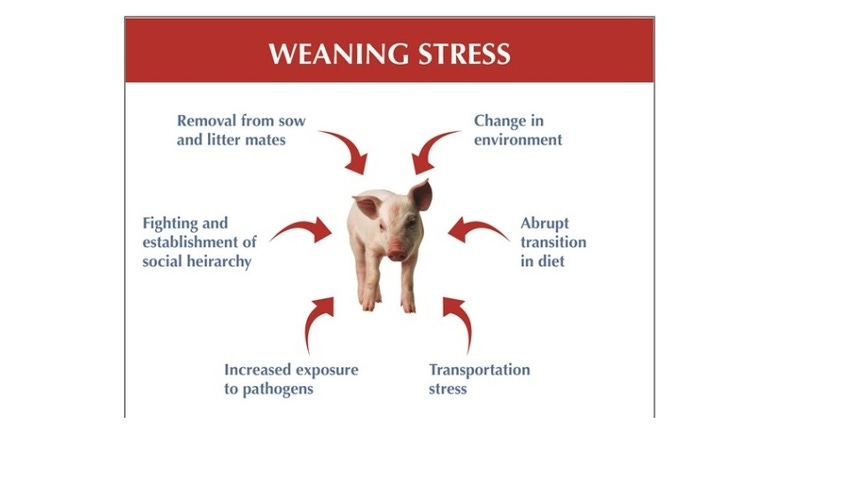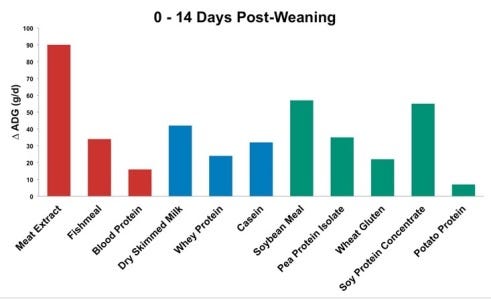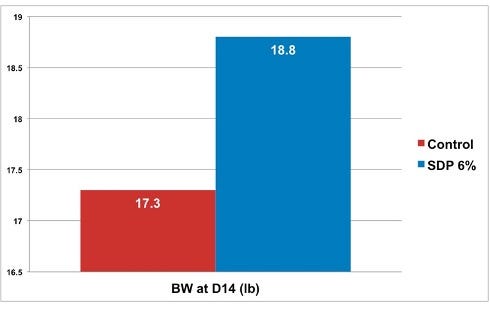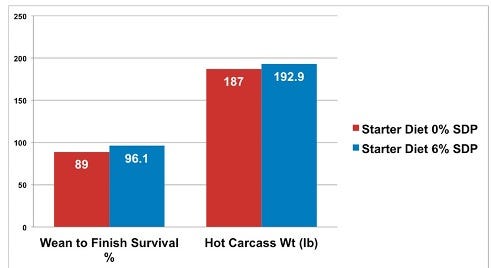November 14, 2014

Editor’s Note: The following article was submitted by APC Inc., in order to help answer questions National Hog Farmer readers may have about the benefits of spray dried plasma in swine diets.
Young pigs are the future of an operation’s productivity. Overall health, growth, and even market weight depend on a weanling pig’s success. Since weaning is one of the most stressful events that pigs experience, producers need to have a tool to get young pigs back on track as fast as possible.
Weaning Stress
Dietary changes, co-mingling, behavioral stress, pathogen exposure and environmental changes are all stressors that a pig experiences at weaning. These stressors activate the pig’s systemic immune system and cause multiple metabolic changes within the pig.
When pigs experience inflammation and intestinal damage associated with weaning stress, they reduce feed intake. Pigs typically lose about 100 to 250 grams (0.22 to 0.55 pounds) of body weight the first day after weaning. It can take up to two weeks after weaning for growth to be restored to pre-weaning growth rates.
If feed intake is not rapidly achieved, post-weaning growth can be further delayed and have long-term negative effects on productivity to market weight. It is well recognized by industry leaders that it can take up to 10 extra days for pigs to achieve market weight if they do not gain weight during the initial week after weaning.
Getting pigs to eat a highly digestible feed as rapidly as possible at weaning is important for both short-term and long-term growth and health. That’s where Spray Dried Plasma (SDP) can help.
Impact of Spray Dried Plasma
For more than 25 years, SDP has been used in pig starter diets. The nutrition it provides has beneficial effects on feed intake, growth and feed efficiency of pigs during the stressful post-weaning phase of production.
SPD is produced from either bovine or porcine blood collected from animals that have been veterinary inspected and approved as fit for slaughter for human consumption and may be sold either as a mixture of bovine or porcine plasma (SDAP), or as a single specie source of plasma such as spray dried porcine plasma (SDPP) or spray dried bovine plasma (SDBP).
A 2001 review of published experiments1 compared the results of SDP in pig starter diets with other specialty proteins during the initial 14 days after weaning. The results showed that pigs with SDP in their diets had:
25% average improvement on average daily gain (ADG)
21% average improvement on feed intake
4% average improvement on feed efficiency
More recently, in a review of more than 70 published experiments it was reported that pigs fed diets containing SDP consistently had greater ADG compared to pigs fed diets with other specialty proteins during the initial 14 days after weaning (Figure 1).

Figure 1
Increase in ADG from day zero to 14 post-weaning of pigs fed diets with SDAP, SDPP and SDBP compared to other specialty protein sources (Adapted from Torrallardona, 2010, Asian-Australian J. Anim. Sci. 23(1):131-148).
* Recent combined data from four nursery experiments2 continue to demonstrate the beneficial effects of the nutrition supplied by SDP. In the trials, 1,209 pigs were fed a starter diet with either 0% or 6% SDP for 14 days after weaning. Pigs with 6% SDP in their diets had a 1.5 pound (0.7 kg) advantage on day 14 body weight (Figure 2).

Figure 2
Combined data of four experiments; 238 pens; 1,209 pigs. Pigs were fed starter diets with 0% or 6% SDAP, SDPP & SDBP for the initial 14 days after weaning. Body weight (BW) at day 14 after weaning was increased by 1.5 lb for pigs fed diet with 6% SDP (APC Inc., unpublished data 2011-13).
Typically, the extra weight at the end of the nursery relates to a 3:1 ratio of final live weight at market. This means that an extra 1.5 pounds of weight at 14 days after weaning would equal 4.5 extra pounds (2.0 kg) at market weight. At current U.S. pork prices, this extra weight at market is worth about an additional $4 per pig slaughtered.
Feeding SDP in starter diets has immediate beneficial effects on post-weaning growth and feed intake. The enhanced nutrition provided by diets with spray dried plasma supports and maintains the intestinal system to help pigs get off to a great start.
Great Start, Great Finish
The research is clear: SDP significantly impacts weanling pig health, growth and success. So what does this mean for pigs after weaning?
Recent research examined the percentage of SDP used in feed, as well as the duration of feeding SDP after weaning. The results demonstrated that the nutrition provided by SDP, when fed at 5% or more, favorably impacts the ability of pigs to withstand stressful events later in life. SDP helped to maintain intestinal barrier function, even after the pigs were no longer fed diets with SDP.
Study Details3
A starter diet with 0% SDPP, or a diet with 2.5% SDPP was fed for seven days after weaning, or a diet with 5% SDPP was fed for the initial 14 days after weaning. Pigs were then fed common diets without SDPP for the rest of the time in the nursery. At day 32 of the study, pigs were subjected to mixing and transport stress and challenged with Salmonella typhimurium.
Two days after challenge, intestinal flux rate was measured. Results indicated that pigs previously fed the diet with 5% SDP for 14 days after weaning did not have increased intestinal permeability in response to Salmonella and transport stress, and were similar to non-stressed control pigs. Pigs subjected to the stress and fed a control diet or the diet with only 2.5% SDP for seven days after weaning had increased intestinal permeability.
These results emphasize the importance of using an appropriate level of dietary SDPP (5%) and feeding duration after weaning (14 days). Because the nutrition provided by SDP enabled the pigs to develop a strong gastrointestinal tract at weaning, the pigs were better able to withstand a stressful event later in life, even after SDP was no longer included in the feed.
Another example of how appropriate starter feed nutrition benefits not only early performance but also a great finish was demonstrated in a recent wean-to-finish study. Pigs were fed a starter diet for 14 days after weaning that contained either 0% or 6% SDPP. Common diets were then fed the rest of the time to market weight.
By day 14, pigs fed the starter diet with 6% SDPP had a 0.75-pound (0.3 kg) weight advantage. By the end of the 145-day wean-to-finish study, survival of pigs fed the starter diet with 0% SDPP was 89% versus 96.1% for pigs fed the starter diet with 6% SDPP, a 7% advantage in survival. Pigs fed the starter diet with 6% SDPP had a 5.9 lb (2.7 kg) advantage for hot carcass weight (Figure 3).

Figure 3
Wean-to-finish survival and hot carcass weight of pigs fed starter diets for 14 days after weaning with either 0% or 6% SDPP and common diets the rest of the time to market weight at day 145 of the study (APC Inc., unpublished data 2014).
Based on current U.S. prices for pork, the improved survival and extra carcass weight of pigs fed the starter diet with 6% SDPP would be worth about $11 per pig.
The research and economic evidence is clear that weaned pigs provided with nutrition from SDP perform better. Pigs should be fed starter diets with at least 5% SDP for the initial 14 days after weaning to help them transition through post-weaning stress and get off to a great start with a great finish.
Authors
Joe Crenshaw, PhD, Director of Technical Services, APC Inc.
Joy Campbell, PhD, Sr. Director of Research & Development N.A., APC Inc.
Javier Polo, PhD, Vice President Research & Development, APC Inc.
1Coffey and Cromwell, 2001, Pig News Info. 22:39N-48N
2APC Inc., unpublished data 2011-13
3Moeser et al., 2013, J. Anim. Sci. 91(Suppl. 2.):119
You May Also Like



